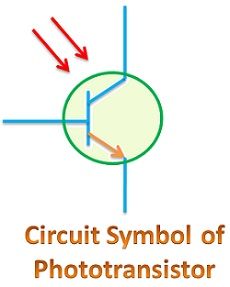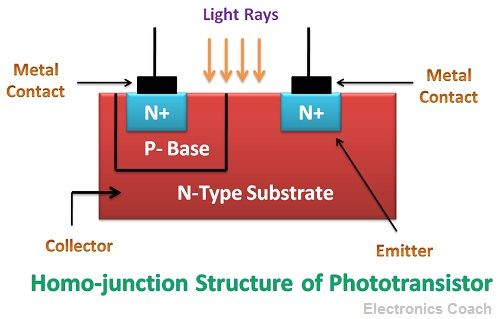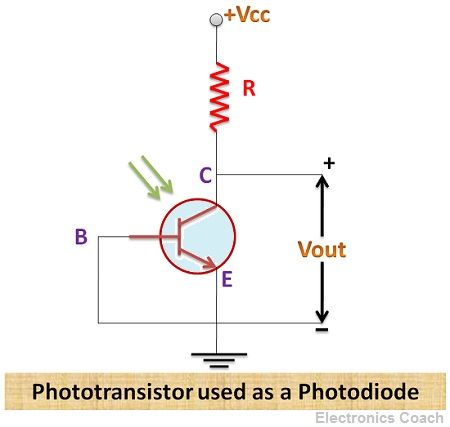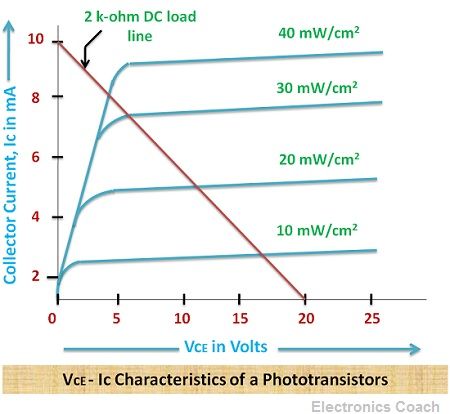Definition: Phototransistors resemble normal transistor except the fact that the base terminal is not present in case of the phototransistor. Phototransistors convert the incident light into photocurrent. Instead of providing the base current for triggering the transistor, the light rays are used to illuminate the base region.
The base terminal is made up of the material which shows sensitivity towards the light. The circuit symbol of the phototransistor is similar to that of the conventional transistor but the base terminal can be omitted. The two arrows point towards phototransistor indicates that the phototransistor is triggered by the light incident on it.
The circuit symbol of the phototransistor is described in the diagram below.

Construction of the Phototransistor
The Phototransistors are manufactured in the similar way by which normal transistor is manufactured, the only difference is the area of the base and collector region in case of phototransistors is quite large as compared to the normal transistor. This is because the more the light falls on the phototransistor the more current it will generate.

The collector and base region are formed by the techniques of ion-implantation and diffusion. The transistor which were used earlier was made of semiconductor material such as Germanium and Silicon and the resulting structure becomes a homogeneous material consist of either Silicon or Germanium.
On the contrary, contemporarily, phototransistors are made up of Group-III and Group-V materials such as GaAs (Gallium Arsenide) in such a way that gallium and arsenide, each of these are used on either side of the transistor. The resulting structure becomes heterogeneous in nature. This type of structure is used widely because the conversion efficiency increases several times as compared to the conversion efficiency of the homogenous transistor.
Working of the Phototransistor
The output of the phototransistor is taken from the emitter terminal and the light rays are allowed to enter the base region. The magnitude of the photocurrent generated by the phototransistor depends on the light intensity of the light falling on the transistor.

It can be of three terminals or two terminals we can omit base as per our requirement. The phototransistor can be operated in three regions that are the cut-off region, active region, and the saturation region. The cut-off region and saturation region can be used to operate the transistor as the switch.
The active region is used for generating current. The current generated from phototransistor depends on several factors apart from luminous intensity such as
- DC current gain of the transistor: The higher the DC current gain of the transistor, the higher will be the intensity of photocurrent generated.
- Time constant: Response time of the transistor also effects the efficiency of phototransistor to generate photocurrent.
- Luminous Sensitivity: The luminous sensitivity can be determined by the ratio between the photoelectric current and incident luminous flux.
- Area of the collector-base junction: The area of the collector-base junction is crucial for the generation of photocurrent, the higher the area of the collector-base junction the higher will be the magnitude of photocurrent generated by the phototransistor.
- Wavelength of the incident light: The wavelength of the light incident on phototransistor controls the amount of photocurrent generated. The higher the wavelength the lower will be the frequency.
Output Characteristics of Phototransistor
The output characteristics of phototransistor can be understood with the help of the diagram below. It shows the variation of collector current with respect to the variation in the emitter-collector voltage.

Advantages of Phototransistor
- Higher Efficiency in Comparison to Photodiode: The efficiency of the phototransistor is higher than that of the photodiode. This is because the current gain in case of the phototransistor is more than that of the photodiode, thus, even if the amount of light incident on both is same the phototransistor will generate more photocurrent than the photodiode.
- Faster Response: The response time of phototransistor is more than that of the photodiode, this provides the advantage of using the phototransistor in our circuit.
- Less Noise interference: The major drawback of photodiodes especially that of avalanche photodiodes is that it is not immune to noise interference. On the contrary, the phototransistors are immune to noise interference.
- Economical: Phototransistor is less costly than other light sensitive device, thus it is economical to use phototransistors in light-sensitive applications.
- Less Complex: The designing of phototransistors is simple and less complex as compared to LDRs and photodiodes.
Disadvantages of Phototransistors
- Effect of Electromagnetic energy: The efficiency of phototransistors decreases when electromagnetic field interferes within the operation region. This results in poor conversion efficiency of phototransistors.
- Poor Performance at high frequency: Due to the large area of the collector-base region, the capacitance increases. Due to this it cannot convert light into photocurrent effectively at higher frequency ranges.
- Electric spikes: It arises in phototransistors more frequently as compared to photodiodes.
Applications of Phototransistors
- Counting Systems: The phototransistors are commonly used in counting systems. As this device works with the help of incident light, thus it is much easy to utilize such device in the computing system, as we don’t need to worry about power supply.
- Encoder sensing and object detection: The phototransistors can be used to detect the object or for encoding.
- Printers and Optical control remotes: Due to its high light to current conversion efficiency, it is commonly used in optical devices such as remotes, printers etc.
- Light detector: The most crucial application of phototransistor is to use it as the light detector. This is because it can detect even a small amount of light because it is highly efficient.
- Level Indication and Relays: The phototransistors are also used to indicate the level in the various system. They also play a vital role in relays and punch cards.
Phototransistors are the crucial optoelectronics device, it is also used in optical fibres. Due to its several advantages over photodiodes, it is more preferred over photodiodes.
Leave a Reply